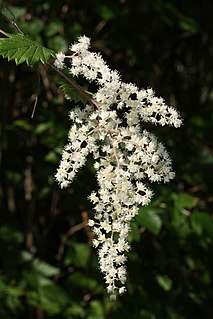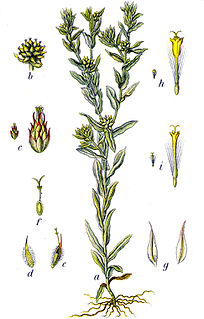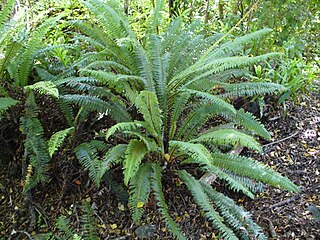
Holodiscus discolor, commonly known as ocean spray or oceanspray, creambush, or ironwood, is a shrub of western North America.

Primula matthioli, synonym Cortusa matthioli, sometimes called alpine bells, is a flowering plant with a wide distribution in the Palearctic, both in Europe and in temperate Asia, from Siberia in the north to Afghanistan, Pakistan and China in the south.

Rubus armeniacus, the Himalayan blackberry or Armenian blackberry, is a species of Rubus in the blackberry group Rubus subgenus Rubus series Discolores Focke. It is native to Armenia and Northern Iran, and widely naturalised elsewhere. Both its scientific name and origin have been the subject of much confusion, with much of the literature referring to it as either Rubus procerus or Rubus discolor, and often mistakenly citing its origin as western European. Flora of North America, published in 2014, considers the taxonomy unsettled, and tentatively uses the older name Rubus bifrons.

Filago vulgaris or Filago germanica, commonly known as common cudweed or common cottonrose, is an annual herbaceous plant of the genus Filago. It is in the tribe Inuleae of the sunflower family, Asteraceae. Common names also include: Danish—Kugle-museurt, and Norwegian—Kuleullurt.
Myrcia hanoverensis is a species of plant in the family Myrtaceae. It is endemic to north-western Jamaica. It is threatened by habitat loss.

Leucadendron discolor is a species of plant in the family Proteaceae. It is endemic to South Africa. It is threatened by habitat loss. In English the plant is known as the Piketberg Conebush and in Afrikaans as the Rooitolbos. L. discolor is a slow growing perennial. Growth of the root system and propagation, from a seed to the plant's first flower, can take up to two years. The male L. discolor 'Sunset' flowers exuberantly during early spring exposing a colorful flowerhead during this time.The flower head is composed of a dome-like receptacle, and is densely covered with small male flowers. These plants are only able to reproduce after their third year of life.

Filago is a genus of plants in the sunflower family, native from Europe and nothern Africa to Mongolia, Nepal, and Macaronesia. They are sometimes called cottonroses or cudweeds.

Logfia is a genus of herbaceous plants in the tribe Gnaphalieae of the family Asteraceae, known as cottonrose.

Lomaria discolor, synonym Blechnum discolor, commonly called crown fern, is a species of fern in the family Blechnaceae. This species is endemic to New Zealand. As noted by C. Michael Hogan, this species is found in a number of forest communities in diverse locations within New Zealand, and is sometimes a dominant understory component.

Zealandia pustulata, synonym Microsorum pustulatum, is a species of fern within the family Polypodiaceae.

Ludisia (Lus.) is a genus of orchids that was thought to contain just one species, Ludisia discolor, commonly referred to as jewel orchid. A second species, Ludisia ravanii, from the Philippines, was described in 2013. Ludisia discolor is native to Southern China, Northeast India, Thailand, Vietnam, the Philippines, Malaysia, Indonesia and Myanmar, and often cultivated.

Dendrobium discolor, commonly known as antler orchids, are epiphytic or lithophytic orchids in the family Orchidaceae. They have cylindrical pseudobulbs, each with between ten and thirty five leathery leaves, and flowering stems with up to forty mostly brownish or greenish flowers with wavy and twisted sepals and petals. Antler orchids occur in northern Australia, New Guinea and Indonesia and there are several subspecies and varieties.
Filago prolifera is a species of flowering plant in the family Asteraceae. It is native to northern Africa and the Arabian peninsula.

Filago pyramidata, the broadleaf cottonrose or broad-leaved cudweed, is a European plant species in the sunflower family. It is native to the Mediterranean region of southern Europe, northern Africa, and the Middle East, plus Great Britain, the Low Countries, and Germany. It is also naturalized in scattered locations in North America and Australia, Pakistan, and other places.

Berchemia discolor, known as bird plum or brown ivory in English, is a tree native to southern and eastern Africa including Madagascar. It is a broadleaf tree growing to 18 m (60 ft).

Filago arvensis is a species of plant belonging to the family Asteraceae.
Zemisia is a genus of flowering plants belonging to the family Asteraceae.
Asterotrichion is a genus of flowering plants belonging to the family Malvaceae.
Loxonia is a genus of flowering plants belonging to the family Gesneriaceae.
Nothocnide is a genus of flowering plants belonging to the family Urticaceae.













